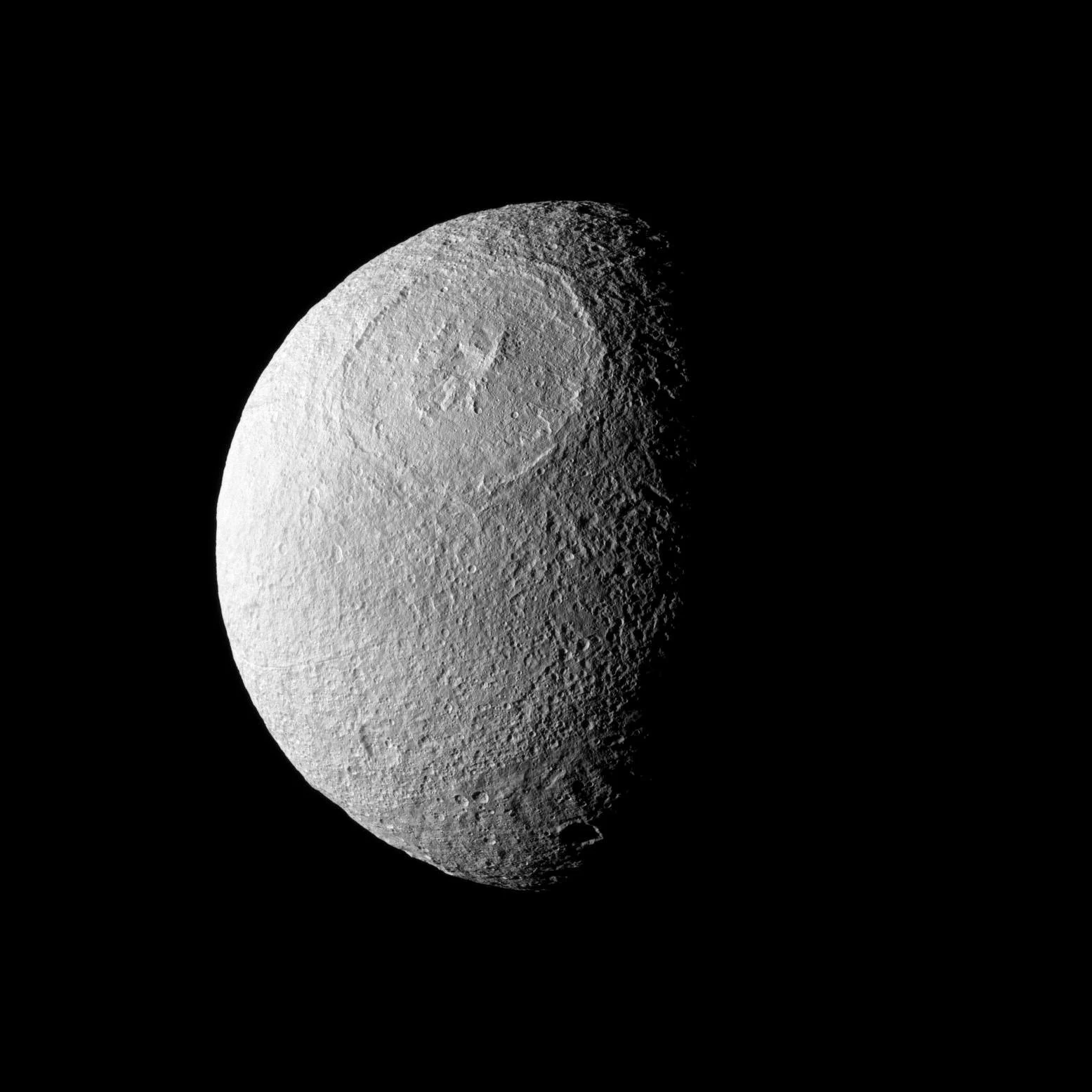Εντυπωσιακή
φωτογραφία με τρία από τα πιο ενδιαφέροντα φεγγάρια του Κρόνου. The
Cassini spacecraft captures a rare family photo of three of Saturn's moons that
couldn't be more different from each other! As the largest of the three, Tethys
(image center) is round and has a variety of terrains across its surface.
Meanwhile, Hyperion (to the upper-left of Tethys) is the "wild one"
with a chaotic spin and Prometheus (lower-left) is a tiny moon that busies
itself sculpting the F ring. Credit: NASA/JPL-Caltech/Space Science Institute
Μια
ακόμη εντυπωσιακή εικόνα από το σύστημα του Κρόνου το οποίο εξερευνά από το
2004 έστειλε το διαστημικό σκάφος Cassini. Στον φακό του σκάφους αυτή τη φορά «ποζάρουν» τρία από τα
δεκάδες φεγγάρια του Άρχοντα των Δαχτυλιδιών του ηλιακού μας συστήματος.
Tethys' trailing
side shows two terrains that tell a story of a rough past. To the north (up, in
the image) is older, rougher terrain, while to the south is new material dubbed
"smooth plains" by scientists. This view looks toward the trailing
hemisphere of Tethys. North on Tethys is up and rotated 2 degrees to the right.
The image was taken in visible light with the Cassini spacecraft narrow-angle
camera on Nov. 27, 2013. Credit: NASA/JPL-Caltech/Space Science Institute
Σε
πρώτο πλάνο εικονίζεται η Τηθύς, ένας παγωμένος δορυφόρος με διάμετρο 1,062 χλμ
η επιφάνεια του οποίου παρουσιάζει μεγάλη ποικιλομορφία. Στη Τηθύ υπάρχουν
μεγάλοι κρατήρες.
Odysseus Crater,
with a size of epic proportions, stretches across a large northern expanse on
Saturn's moon Tethys. This view looks toward the leading hemisphere of Tethys
(1,062 kilometers, or 660 miles across). Odysseus Crater is 450 kilometers, or
280 miles, across. North on Tethys is up and rotated 3 degrees to the right. The
image was taken in visible green light with the Cassini spacecraft narrow-angle
camera on Feb. 14, 2010. The view was obtained at a distance of approximately
178,000 kilometers (111,000 miles) from Tethys and at a Sun-Tethys-spacecraft,
or phase, angle of 73 degrees. Image scale is about 1 kilometer (about 3,485
feet) per pixel. Credit: NASA/JPL/Space Science Institute
Ο μεγαλύτερος ονομάζεται «Οδυσσέας» και έχει διάμετρο 400 χιλιόμετρα. Ένα άλλο εντυπωσιακό χαρακτηριστικό της
επιφάνειάς της Τηθύος είναι το «Χάσμα της Ιθάκης», ένα φαράγγι πλάτους εκατό
χιλιομέτρων και βάθους πέντε.
The Cassini
spacecraft looks at Saturn's highly irregular moon Hyperion in this view from
the spacecraft's flyby of the moon on Aug. 25, 2011. Hyperion (168 miles, or
270 kilometers across) has an irregular shape, and it tumbles through its
orbit: that is, it does not spin at a constant rate or in a constant
orientation. (A standard reference latitude-longitude system has not yet been
devised for this moon.) Images such as this one extend previous coverage and
allow a better inventory of the surface features, the satellite's shape and
changes in its spin. Credit: NASA/JPL-Caltech/Space Science Institute
Πάνω
αριστερά στην εικόνα διακρίνεται ο Υπερίωνας, ένας από τους πιο ενδιαφέροντες
δορυφόρους όχι μόνο του Κρόνου αλλά ολόκληρου του ηλιακού μας συστήματος. Η
περιστροφή του Υπερίωνα είναι χαοτική, δηλαδή ο άξονας του ταλαντεύεται τόσο
πολύ, ώστε ο προσανατολισμός του στο διάστημα είναι απρόβλεπτος. Ο Υπερίωνας
έχει διάμετρο 270 χλμ και είναι ο μόνος γνωστός δορυφόρος του ηλιακού μας
συστήματος που περιφέρεται χαοτικά. Είναι ακόμα ο μοναδικός ομαλός δορυφόρος
στο Ηλιακό Σύστημα που δεν είναι παλιρροϊκά κλειδωμένος με τον πλανήτη του.
Κάτω αριστερά διακρίνεται ο Προμηθέας, ένας μικρός δορυφόρος με διάμετρο 86 χλμ που ακουμπά πάνω σε ένα από τα μεγάλα δαχτυλίδια του Κρόνου. Ο Προμηθέας έχει επίμηκες σχήμα ενώ στην επιφάνειά του υπάρχουν αρκετές κορυφογραμμές, κοιλάδες και πολλοί κρατήρες.
Saturn's moon
Prometheus orbits near some of its handiwork in the F ring. Prometheus (53
miles, or 86 kilometers across) and its partner Pandora gravitationally sculpt
and maintain the narrow F ring. This view looks toward the unilluminated side
of the rings from about 53 degrees below the ringplane. The image was taken in
visible light with the Cassini spacecraft narrow-angle camera on Aug. 24, 2013.
Credit: NASA/JPL-Caltech/Space Science Institute
Κάτω αριστερά διακρίνεται ο Προμηθέας, ένας μικρός δορυφόρος με διάμετρο 86 χλμ που ακουμπά πάνω σε ένα από τα μεγάλα δαχτυλίδια του Κρόνου. Ο Προμηθέας έχει επίμηκες σχήμα ενώ στην επιφάνειά του υπάρχουν αρκετές κορυφογραμμές, κοιλάδες και πολλοί κρατήρες.






Δεν υπάρχουν σχόλια:
Δημοσίευση σχολίου